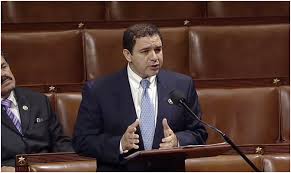
99 percent satisfaction at TSA? Congressman questions agencies’ customer service data
Rep. Henry Cuellar (D-Texas) said agencies are too selective about what they choose to include or omit in their progress reports on customer service. Instead,...
Agencies are too selective about what they choose to include — and omit — in their quarterly customer service reports on Performance.gov, one congressman said. And he wants agencies to start holding themselves to higher performance standards, preferably measures they don’t create for themselves.
Take the Transportation Security Administration, for example. Of the six performance indicators TSA lists on Performance.gov, only one shows the agency’s customer satisfaction scores. And that score only measures customer satisfaction with TSA’s PreCheck security screening process, not the regular screening process most airport passengers travel through.

A fiscal 2015 quarter four update on Performance.gov — the most recent report available — says TSA earned a 99 percent customer satisfaction score from PreCheck passengers.
“Everybody’s pretty happy with PreCheck,” Rep. Henry Cuellar (D-Texas) said at Government Executive’s customer experience summit in Washington June 7. “They don’t go [to] the other lines. If you put [in] the other lines, especially this summer or maybe a couple months ago, do you think they would be getting 100 percent?”
To calculate the satisfaction score, the agency used data “based on the number of TSA PreCheck complaints received by the TSA Contact Center divided by the number of passengers that received TSA PreCheck screening. It is assumed that those not submitting complaints are satisfied with TSA PreCheck,” Performance.gov says.
But if agencies are going to continue to measure customer service satisfaction themselves, Cuellar said they need to do better.
“We need to push ourselves a little bit more on measurements,” he said.
Cuellar introduced the 2010 update to the Government Performance and Results Act, which prompted the creation of the administration’s cross agency priority goals and required that agencies publish quarterly assessments on their progress. Now, Cuellar said Congress needs to “fine tune” the law and openly called for suggestions on ways to improve it.
“The one I want to see is to really have more of the interaction, there is language there, but I want to make it stronger, the interaction between the agencies and the Congress,” he said.
Agencies should be more transparent about their reports on Performance.gov, Cuellar added.
Cuellar included two provisions in the latest version of the 2017 Financial Services and General Government Appropriations bill, which the House Appropriations Committee will likely vote on later this week, to put more pressure on agencies to improve their performance.
The provisions encourage agencies to work collectively with the Office of Management and Budget to develop performance standards, which Congress would include in its appropriations bills.
“In other words, if you’re asking for money, we want to know how you’re doing it,” Cuellar said. “Have we got to that level yet? No, we haven’t. Are we getting there? I think we are.”
The Obama administration acknowledged agencies’ challenges with customer service, including it as one of 15 cross-agency priority goals.
The Office of Management and Budget also launched the Core Federal Services Council March 30, a consortium of agency leaders representing 30 different federal programs that serve the public.
The council’s leaders want to make sure the ideas and best practices they identify and develop endure the upcoming presidential transition. The council has funding for the next two years.
“We recognized quickly that we needed to identify senior, career operational leaders from each of the agencies,” Kala Shah, a White House Leadership Development fellow at OMB, said of the customer service council. “We’re looking at embedding this as a long term performance improvement customer experience management process piece that will survive this administration. That should continue because this governance structure enables us to look across government and identify strategies at an enterprise-wide level.”
To measure agencies’ progress on customer service, Shah said the council is considering a self-assessment tool that all 30 programs could use to measure their success. The tool could incorporate public feedback data, similar to the kind of information that four agencies are now collecting through the General Services Administration’s FeedbackUSA customer service pilot.
Three agencies currently collect public feedback from that pilot, including the State and Veterans Affairs departments, as well as the Social Security Administration. U.S. Citizenship and Immigration Services will begin using the program this spring, Shah said.
But although Cuellar questioned the validity of agencies’ self-assessments and the data they collect to measure their performance, OMB suggested it doesn’t have plans to get out of the business of measuring and reporting their own progress.
Shah said OMB will consider “broadening the kind of data” that it uses.
“There isn’t a magic data point that is going to answer the question of how we are doing in serving the public across these 30 programs,” Shah said. “There’s transactional feedback data. There’s overall satisfaction data, looking both at data that is collected by the agency and programs from within, as well as data that’s collected from outside, whether that’s through ACSI or other sources of data.”
Shah said the council is working with individual agencies programs to determine what data points make the most sense for each of them.
“We have a long way to go within government in terms of understanding how our programs are doing, and we’re at different maturity levels,” she said. “We’re not at a point where we’re going to have one needle measurement that’s going to work across all of our programs. We’re in very different journeys. We are in very different industries. … But we are at a point where we are aware of that.”
Copyright © 2025 Federal News Network. All rights reserved. This website is not intended for users located within the European Economic Area.
Nicole Ogrysko is a reporter for Federal News Network focusing on the federal workforce and federal pay and benefits.
Follow @nogryskoWFED




